This is a list of the mammal species recorded in Chad. There are 136 mammal species in Chad, of which four are critically endangered, two are endangered, eight are vulnerable, and two are near threatened. One of the species listed for Chad can no longer be found in the wild.
The following tags are used to highlight each species' conservation status as assessed by the International Union for Conservation of Nature:
| EX | Extinct | No reasonable doubt that the last individual has died. |
| EW | Extinct in the wild | Known only to survive in captivity or as a naturalized populations well outside its previous range. |
| CR | Critically endangered | The species is in imminent risk of extinction in the wild. |
| EN | Endangered | The species is facing an extremely high risk of extinction in the wild. |
| VU | Vulnerable | The species is facing a high risk of extinction in the wild. |
| NT | Near threatened | The species does not meet any of the criteria that would categorise it as risking extinction but it is likely to do so in the future. |
| LC | Least concern | There are no current identifiable risks to the species. |
| DD | Data deficient | There is inadequate information to make an assessment of the risks to this species. |
Some species were assessed using an earlier set of criteria. Species assessed using this system have the following instead of near threatened and least concern categories:
| LR/cd | Lower risk/conservation dependent | Species which were the focus of conservation programmes and may have moved into a higher risk category if that programme was discontinued. |
| LR/nt | Lower risk/near threatened | Species which are close to being classified as vulnerable but are not the subject of conservation programmes. |
| LR/lc | Lower risk/least concern | Species for which there are no identifiable risks. |
Order: Afrosoricida (tenrecs and golden moles)
The order Afrosoricida contains the golden moles of southern Africa and the tenrecs of Madagascar and Africa, two families of small mammals that were traditionally part of the order Insectivora.
- Family: Tenrecidae (tenrecs)
- Subfamily: Potamogalinae
- Genus: Potamogale
- Giant otter shrew, Potamogale velox LC
- Genus: Potamogale
- Subfamily: Potamogalinae
Order: Tubulidentata (aardvarks)

The order Tubulidentata consists of a single species, the aardvark. Tubulidentata are characterised by their teeth which lack a pulp cavity and form thin tubes which are continuously worn down and replaced.
- Family: Orycteropodidae
- Genus: Orycteropus
- Aardvark, O. afer LC
- Genus: Orycteropus
Order: Hyracoidea (hyraxes)
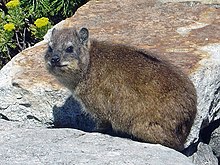
The hyraxes are any of four species of fairly small, thickset, herbivorous mammals in the order Hyracoidea. About the size of a domestic cat they are well-furred, with rounded bodies and a stumpy tail. They are native to Africa and the Middle East.
- Family: Procaviidae (hyraxes)
- Genus: Procavia
- Cape hyrax, Procavia capensis LC
- Genus: Procavia
Order: Proboscidea (elephants)
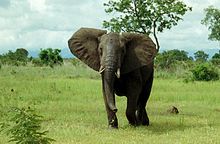
The elephants comprise three living species and are the largest living land animals.
- Family: Elephantidae (elephants)
- Genus: Loxodonta
- African bush elephant, L. africana EN
- Genus: Loxodonta
Order: Sirenia (manatees and dugongs)
Sirenia is an order of fully aquatic, herbivorous mammals that inhabit rivers, estuaries, coastal marine waters, swamps, and marine wetlands. All four species are endangered.
- Family: Trichechidae
- Genus: Trichechus
- African manatee, Trichechus senegalensis VU
- Genus: Trichechus
Order: Primates

The order Primates contains humans and their closest relatives: lemurs, lorisoids, tarsiers, monkeys, and apes.
- Suborder: Strepsirrhini
- Infraorder: Lemuriformes
- Superfamily: Lorisoidea
- Family: Galagidae
- Genus: Galago
- Senegal bushbaby, Galago senegalensis LR/lc
- Genus: Galago
- Family: Galagidae
- Superfamily: Lorisoidea
- Infraorder: Lemuriformes
- Suborder: Haplorhini
- Infraorder: Simiiformes
- Parvorder: Catarrhini
- Superfamily: Cercopithecoidea
- Family: Cercopithecidae (Old World monkeys)
- Genus: Erythrocebus
- Patas monkey, Erythrocebus patas LR/lc
- Genus: Chlorocebus
- Tantalus monkey, Chlorocebus tantalus LR/lc
- Genus: Papio
- Olive baboon, Papio anubis LR/lc
- Subfamily: Colobinae
- Genus: Colobus
- Mantled guereza, Colobus guereza LR/lc
- Genus: Colobus
- Genus: Erythrocebus
- Family: Cercopithecidae (Old World monkeys)
- Superfamily: Cercopithecoidea
- Parvorder: Catarrhini
- Infraorder: Simiiformes
Order: Rodentia (rodents)
Rodents make up the largest order of mammals, with over 40% of mammalian species. They have two incisors in the upper and lower jaw which grow continually and must be kept short by gnawing. Most rodents are small though the capybara can weigh up to 45 kg (99 lb).
- Suborder: Hystricognathi
- Family: Hystricidae (Old World porcupines)
- Genus: Hystrix
- Crested porcupine, Hystrix cristata LC
- Genus: Hystrix
- Family: Thryonomyidae (cane rats)
- Genus: Thryonomys
- Lesser cane rat, Thryonomys gregorianus LC
- Genus: Thryonomys
- Family: Hystricidae (Old World porcupines)
- Suborder: Sciurognathi
- Family: Sciuridae (squirrels)
- Subfamily: Xerinae
- Tribe: Xerini
- Genus: Xerus
- Striped ground squirrel, Xerus erythropus LC
- Genus: Xerus
- Tribe: Protoxerini
- Genus: Heliosciurus
- Gambian sun squirrel, Heliosciurus gambianus LC
- Genus: Heliosciurus
- Tribe: Xerini
- Subfamily: Xerinae
- Family: Nesomyidae
- Subfamily: Cricetomyinae
- Genus: Cricetomys
- Gambian pouched rat, Cricetomys gambianus LC
- Genus: Cricetomys
- Subfamily: Cricetomyinae
- Family: Muridae (mice, rats, voles, gerbils, hamsters, etc.)
- Subfamily: Deomyinae
- Genus: Acomys
- Western Saharan spiny mouse, Acomys airensis LC
- Johan's spiny mouse, Acomys johannis LC
- Genus: Uranomys
- Rudd's mouse, Uranomys ruddi LC
- Genus: Acomys
- Subfamily: Gerbillinae
- Genus: Desmodilliscus
- Pouched gerbil, Desmodilliscus braueri LC
- Genus: Dipodillus
- North African gerbil, Dipodillus campestris LC
- Genus: Gerbillus
- Agag gerbil, Gerbillus agag DD
- Lesser Egyptian gerbil, Gerbillus gerbillus LC
- Pygmy gerbil, Gerbillus henleyi LC
- Sudan gerbil, Gerbillus nancillus DD
- Balochistan gerbil, Gerbillus nanus LC
- Nigerian gerbil, Gerbillus nigeriae LC
- Greater Egyptian gerbil, Gerbillus pyramidum LC
- Tarabul's gerbil, Gerbillus tarabuli LC
- Genus: Tatera
- Kemp's gerbil, Tatera kempi LC
- Fringe-tailed gerbil, Tatera robusta LC
- Genus: Taterillus
- Congo gerbil, Taterillus congicus LC
- Gracile tateril, Taterillus gracilis LC
- Genus: Desmodilliscus
- Subfamily: Murinae
- Genus: Arvicanthis
- African grass rat, Arvicanthis niloticus LC
- Genus: Lemniscomys
- Typical striped grass mouse, Lemniscomys striatus LC
- Heuglin's striped grass mouse, Lemniscomys zebra LC
- Genus: Mastomys
- Guinea multimammate mouse, Mastomys erythroleucus LC
- Verheyen's multimammate mouse, Mastomys kollmannspergeri LC
- Natal multimammate mouse, Mastomys natalensis LC
- Genus: Praomys
- Dalton's mouse, Praomys daltoni LC
- Genus: Arvicanthis
- Subfamily: Deomyinae
- Family: Ctenodactylidae
- Genus: Massoutiera
- Mzab gundi, Massoutiera mzabi LC
- Genus: Massoutiera
- Family: Sciuridae (squirrels)
Order: Lagomorpha (lagomorphs)
The lagomorphs comprise two families, Leporidae (hares and rabbits), and Ochotonidae (pikas). Though they can resemble rodents, and were classified as a superfamily in that order until the early 20th century, they have since been considered a separate order. They differ from rodents in a number of physical characteristics, such as having four incisors in the upper jaw rather than two.
- Family: Leporidae (rabbits, hares)
- Genus: Poelagus
- Bunyoro rabbit, Poelagus marjorita LR/lc
- Genus: Lepus
- Cape hare, Lepus capensis LR/lc
- African savanna hare, Lepus microtis LR/lc
- Genus: Poelagus
Order: Erinaceomorpha (hedgehogs and gymnures)
The order Erinaceomorpha contains a single family, Erinaceidae, which comprise the hedgehogs and gymnures. The hedgehogs are easily recognised by their spines while gymnures look more like large rats.
- Family: Erinaceidae (hedgehogs)
- Subfamily: Erinaceinae
- Genus: Atelerix
- Four-toed hedgehog, Atelerix albiventris LR/lc
- Genus: Hemiechinus
- Desert hedgehog, Hemiechinus aethiopicus LR/lc
- Genus: Atelerix
- Subfamily: Erinaceinae
Order: Soricomorpha (shrews, moles, and solenodons)
The "shrew-forms" are insectivorous mammals. The shrews and solenodons closely resemble mice while the moles are stout-bodied burrowers.
- Family: Soricidae (shrews)
- Subfamily: Crocidurinae
- Genus: Crocidura
- Fox's shrew, Crocidura foxi LC
- Savanna shrew, Crocidura fulvastra LC
- Bicolored musk shrew, Crocidura fuscomurina LC
- Small-footed shrew, Crocidura parvipes LC
- Savanna path shrew, Crocidura viaria LC
- Voi shrew, Crocidura voi LC
- Yankari shrew, Crocidura yankariensis LC
- Genus: Crocidura
- Subfamily: Crocidurinae
Order: Chiroptera (bats)
The bats' most distinguishing feature is that their forelimbs are developed as wings, making them the only mammals capable of flight. Bat species account for about 20% of all mammals.
- Family: Pteropodidae (flying foxes, Old World fruit bats)
- Subfamily: Pteropodinae
- Genus: Eidolon
- Straw-coloured fruit bat, Eidolon helvum LC
- Genus: Epomophorus
- Gambian epauletted fruit bat, Epomophorus gambianus LC
- Ethiopian epauletted fruit bat, Epomophorus labiatus LC
- Genus: Micropteropus
- Peters's dwarf epauletted fruit bat, Micropteropus pusillus LC
- Genus: Eidolon
- Subfamily: Pteropodinae
- Family: Vespertilionidae
- Subfamily: Vespertilioninae
- Genus: Glauconycteris
- Butterfly bat, Glauconycteris variegata LC
- Genus: Neoromicia
- Tiny serotine, Neoromicia guineensis LC
- Banana pipistrelle, Neoromicia nanus LC
- Rendall's serotine, Neoromicia rendalli LC
- Somali serotine, Neoromicia somalicus LC
- Genus: Nycticeinops
- Schlieffen's bat, Nycticeinops schlieffeni LC
- Genus: Pipistrellus
- Rüppell's pipistrelle, Pipistrellus rueppelli LC
- Rusty pipistrelle, Pipistrellus rusticus LC
- Genus: Scotoecus
- Dark-winged lesser house bat, Scotoecus hirundo DD
- Genus: Scotophilus
- White-bellied yellow bat, Scotophilus leucogaster LC
- Greenish yellow bat, Scotophilus viridis LC
- Genus: Glauconycteris
- Subfamily: Vespertilioninae
- Family: Rhinopomatidae
- Genus: Rhinopoma
- Egyptian mouse-tailed bat, R. cystops LC
- Lesser mouse-tailed bat, Rhinopoma hardwickei LC
- Greater mouse-tailed bat, Rhinopoma microphyllum LC
- Genus: Rhinopoma
- Family: Molossidae
- Genus: Chaerephon
- Gland-tailed free-tailed bat, Chaerephon bemmeleni LC
- Nigerian free-tailed bat, Chaerephon nigeriae LC
- Little free-tailed bat, Chaerephon pumila LC
- Genus: Mops
- Midas free-tailed bat, Mops midas LC
- Genus: Chaerephon
- Family: Emballonuridae
- Genus: Taphozous
- Hamilton's tomb bat, Taphozous hamiltoni NT
- Mauritian tomb bat, Taphozous mauritianus LC
- Naked-rumped tomb bat, Taphozous nudiventris LC
- Genus: Taphozous
- Family: Nycteridae
- Genus: Nycteris
- Hairy slit-faced bat, Nycteris hispida LC
- Large-eared slit-faced bat, Nycteris macrotis LC
- Egyptian slit-faced bat, Nycteris thebaica LC
- Genus: Nycteris
- Family: Megadermatidae
- Genus: Lavia
- Yellow-winged bat, Lavia frons LC
- Genus: Lavia
- Family: Rhinolophidae
- Subfamily: Rhinolophinae
- Genus: Rhinolophus
- Rüppell's horseshoe bat, Rhinolophus fumigatus LC
- Genus: Rhinolophus
- Subfamily: Hipposiderinae
- Genus: Asellia
- Trident leaf-nosed bat, Asellia tridens LC
- Genus: Hipposideros
- Sundevall's roundleaf bat, Hipposideros caffer LC
- Noack's roundleaf bat, Hipposideros ruber LC
- Genus: Asellia
- Subfamily: Rhinolophinae
Order: Pholidota (pangolins)
The order Pholidota comprises the eight species of pangolin. Pangolins are anteaters and have the powerful claws, elongated snout and long tongue seen in the other unrelated anteater species.
- Family: Manidae
- Genus: Manis
- Giant pangolin, Manis gigantea LR/lc
- Ground pangolin, Manis temminckii LR/nt
- Genus: Manis
Order: Carnivora (carnivorans)

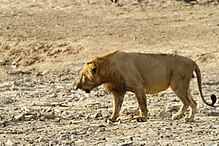
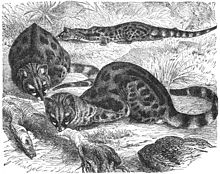

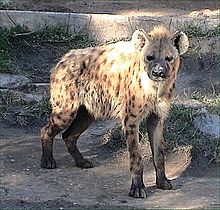
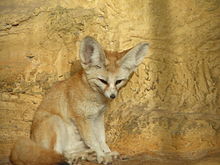
There are over 260 species of carnivorans, the majority of which feed primarily on meat. They have a characteristic skull shape and dentition.
- Suborder: Feliformia
- Family: Felidae (cats)
- Subfamily: Felinae
- Genus: Acinonyx
- Cheetah, A. jubatus
- Northwest African cheetah, A. j. hecki CR
- Cheetah, A. jubatus
- Genus: Caracal
- Caracal, C. caracal LC
- Genus: Felis
- African wildcat, F. lybica LC
- Sand cat, F. margarita LC
- Genus: Leptailurus
- Serval, L. serval LC
- Genus: Acinonyx
- Subfamily: Pantherinae
- Genus: Panthera
- Lion, P. leo VU
- West African lion, P. l. leo CR
- Leopard, P. pardus VU
- Lion, P. leo VU
- Genus: Panthera
- Subfamily: Felinae
- Family: Viverridae
- Subfamily: Viverrinae
- Genus: Genetta
- Common genet, G. genetta LC
- Rusty-spotted genet, G. maculata LC
- Genus: Genetta
- Subfamily: Viverrinae
- Family: Herpestidae (mongooses)
- Genus: Herpestes
- Egyptian mongoose, H. ichneumon LC
- Genus: Mungos
- Banded mongoose, M. mungo LC
- Genus: Herpestes
- Family: Hyaenidae (hyaenas)
- Genus: Crocuta
- Spotted hyena, C. crocuta LC
- Genus: Hyaena
- Striped hyena, H. hyaena LC
- Genus: Crocuta
- Family: Felidae (cats)
- Suborder: Caniformia
- Family: Canidae (dogs, foxes)
- Genus: Canis
- African golden wolf, C. lupaster LC
- Genus: Vulpes
- Pale fox, V. pallida LC
- Rüppell's fox, V. rueppellii LC
- Fennec fox, V. zerda LC
- Genus: Lupulella
- Side-striped jackal, L. adusta LC
- Genus: Lycaon
- African wild dog, L. pictus EN
- Genus: Canis
- Family: Mustelidae (mustelids)
- Genus: Ictonyx
- Saharan striped polecat, Ictonyx libyca LC
- Striped polecat, Ictonyx striatus LC
- Genus: Mellivora
- Honey badger, M. capensis LC
- Genus: Hydrictis
- Speckle-throated otter, H. maculicollis NT
- Genus: Aonyx
- African clawless otter, A. capensis NT
- Genus: Ictonyx
- Family: Canidae (dogs, foxes)
Order: Perissodactyla (odd-toed ungulates)

The odd-toed ungulates are browsing and grazing mammals. They are usually large to very large, and have relatively simple stomachs and a large middle toe.
- Family: Rhinocerotidae
- Genus: Diceros
- Black rhinoceros, D. bicornis
- Western black rhinoceros, D. b. longipes EX
- Black rhinoceros, D. bicornis
- Genus: Ceratotherium
- White rhinoceros, C. simum extirpated
- Northern white rhinoceros, C. s. cottoni CR
- White rhinoceros, C. simum extirpated
- Genus: Diceros
Order: Artiodactyla (even-toed ungulates)


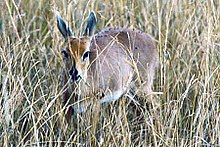

The even-toed ungulates are ungulates whose weight is borne about equally by the third and fourth toes, rather than mostly or entirely by the third as in perissodactyls. There are about 220 artiodactyl species, including many that are of great economic importance to humans.
- Family: Suidae (pigs)
- Subfamily: Phacochoerinae
- Genus: Phacochoerus
- Common warthog, Phacochoerus africanus LR/lc
- Genus: Phacochoerus
- Subfamily: Suinae
- Genus: Potamochoerus
- Red river hog, Potamochoerus porcus LR/lc
- Genus: Potamochoerus
- Subfamily: Phacochoerinae
- Family: Hippopotamidae (hippopotamuses)
- Genus: Hippopotamus
- Hippopotamus, Hippopotamus amphibius VU
- Genus: Hippopotamus
- Family: Giraffidae (giraffe, okapi)
- Genus: Giraffa
- Kordofan giraffe, Giraffa camelopardalis antiquorum CR
- Genus: Giraffa
- Family: Bovidae (cattle, antelope, sheep, goats)
- Subfamily: Alcelaphinae
- Genus: Alcelaphus
- Hartebeest, Alcelaphus buselaphus LR/cd
- Genus: Damaliscus
- Topi, Damaliscus lunatus LR/cd
- Genus: Alcelaphus
- Subfamily: Antilopinae
- Genus: Gazella
- Dorcas gazelle, Gazella dorcas VU
- Rhim gazelle, Gazella leptoceros EN
- Red-fronted gazelle, Gazella rufifrons VU
- Genus: Nanger
- Dama gazelle, Nanger dama CR
- Genus: Ourebia
- Oribi, Ourebia ourebi LR/cd
- Genus: Gazella
- Subfamily: Bovinae
- Genus: Syncerus
- African buffalo, Syncerus caffer LR/cd
- Genus: Tragelaphus
- Giant eland, Tragelaphus derbianus LR/nt
- Bushbuck, Tragelaphus scriptus LR/lc
- Sitatunga, Tragelaphus spekii LR/nt
- Greater kudu, Tragelaphus strepsiceros LR/cd
- Genus: Syncerus
- Subfamily: Caprinae
- Genus: Ammotragus
- Barbary sheep, Ammotragus lervia VU
- Genus: Ammotragus
- Subfamily: Cephalophinae
- Genus: Cephalophus
- Red-flanked duiker, Cephalophus rufilatus LR/cd
- Yellow-backed duiker, Cephalophus silvicultor LR/nt
- Genus: Sylvicapra
- Common duiker, Sylvicapra grimmia LR/lc
- Genus: Cephalophus
- Subfamily: Hippotraginae
- Genus: Addax
- Addax, Addax nasomaculatus CR
- Genus: Hippotragus
- Roan antelope, Hippotragus equinus LR/cd
- Genus: Oryx
- Scimitar oryx, Oryx dammah EN reintroduced
- Genus: Addax
- Subfamily: Reduncinae
- Genus: Kobus
- Genus: Redunca
- Bohor reedbuck, Redunca redunca LC
- Subfamily: Alcelaphinae
References
- This list is derived from the IUCN Red List which lists species of mammals and includes those mammals that have recently been classified as extinct (since 1500 AD). The taxonomy and naming of the individual species is based on those used in existing Misplaced Pages articles as of 21 May 2007 and supplemented by the common names and taxonomy from the IUCN, Smithsonian Institution, or University of Michigan where no Misplaced Pages article was available.
- Gobush, K.S.; Edwards, C.T.T.; Maisels, F.; Wittemyer, G.; Balfour, D.; Taylor, R.D. (2021). "Loxodonta cyclotis". IUCN Red List of Threatened Species. 2021: e.T181007989A204404464. doi:10.2305/IUCN.UK.2021-1.RLTS.T181007989A204404464.en. Retrieved 18 November 2021.
- Benda, P. (2017). "Rhinopoma cystops". IUCN Red List of Threatened Species. 2017: e.T82345555A82345569.
- Durant, S.; Mitchell, N.; Ipavec, A. & Groom, R. (2015). "Acinonyx jubatus". IUCN Red List of Threatened Species. 2015: e.T219A50649567.
- Belbachir, F. (2008). "Acinonyx jubatus ssp. hecki". IUCN Red List of Threatened Species. 2008: e.T221A13035738.
- Avgan, B.; Henschel, P. & Ghoddousi, A. (2016). "Caracal caracal". IUCN Red List of Threatened Species. 2016: e.T3847A102424310.
- Ghoddousi, A.; Belbachir, F.; Durant, S.M.; Herbst, M. & Rosen, T. (2022). "Felis lybica". IUCN Red List of Threatened Species. 2022: e.T131299383A154907281. doi:10.2305/IUCN.UK.2022-1.RLTS.T131299383A154907281.en.
- Sliwa, A.; Ghadirian, T.; Appel, A.; Banfield, L.; Sher Shah, M. & Wacher, T. (2016). "Felis margarita". IUCN Red List of Threatened Species. 2016: e.T8541A50651884.
- Thiel, C. (2015). "Leptailurus serval". IUCN Red List of Threatened Species. 2015: e.T11638A50654625.
- Bauer, H.; Packer, C.; Funston, P. F.; Henschel, P. & Nowell, K. (2016). "Panthera leo". IUCN Red List of Threatened Species. 2016: e.T15951A115130419.
- Stein, A.B.; Athreya, V.; Gerngross, P.; Balme, G.; Henschel, P.; Karanth, U.; Miquelle, D.; Rostro-Garcia, S.; Kamler, J. F.; Laguardia, A.; Khorozyan, I. & Ghoddousi, A. (2019). "Panthera pardus". IUCN Red List of Threatened Species. 2019: e.T15954A160698029.
- Gaubert, P.; Carvalho, F.; Camps, D. & Do Linh San, E. (2015). "Genetta genetta". IUCN Red List of Threatened Species. 2015: e.T41698A45218636.
- Angelici, F.M.; Gaubert, P. & Do Linh San, E. (2016). "Genetta maculata". IUCN Red List of Threatened Species. 2016: e.T41699A45218948.
- Do Linh San, E.; Maddock, A.H.; Gaubert, P. & Palomares, F. (2016). "Herpestes ichneumon". IUCN Red List of Threatened Species. 2016: e.T41613A45207211.
- AbiSaid, M. & Dloniak, S.M.D. (2015). "Hyaena hyaena". IUCN Red List of Threatened Species. 2015: e.T10274A45195080.
- Mallon, D.; Murdoch, J.D. & Wacher, T. (2015). "Vulpes rueppelli". IUCN Red List of Threatened Species. 2015: e.T23053A46197483.
- Wacher, T.; Bauman, K. & Cuzin, F. (2015). "Vulpes zerda". IUCN Red List of Threatened Species. 2015: e.T41588A46173447.
- Woodroffe, R. & Sillero-Zubiri, C. (2020). "Lycaon pictus". IUCN Red List of Threatened Species. 2020: e.T12436A166502262.
- Do Linh San, E.; Begg, C.; Begg, K. & Abramov, A. V. (2016). "Mellivora capensis". IUCN Red List of Threatened Species. 2016: e.T41629A45210107.
- Reed-Smith, J.; Jacques, H. & Somers, M.J. (2015). "Hydrictis maculicollis". IUCN Red List of Threatened Species. 2015: e.T12420A21936042.
- Jacques, H.; Reed-Smith & Somers, M.J. "Aonyx capensis". IUCN Red List of Threatened Species: e.T1793A21938767.
External links
- "Animal Diversity Web". University of Michigan Museum of Zoology. 1995–2006. Retrieved 22 May 2007.
See also
- List of chordate orders
- Lists of mammals by region
- List of prehistoric mammals
- Mammal classification
- List of mammals described in the 2000s
| List of mammals of Africa | |
|---|---|
| Sovereign states |
|
| States with limited recognition | |
| Dependencies and other territories |
|